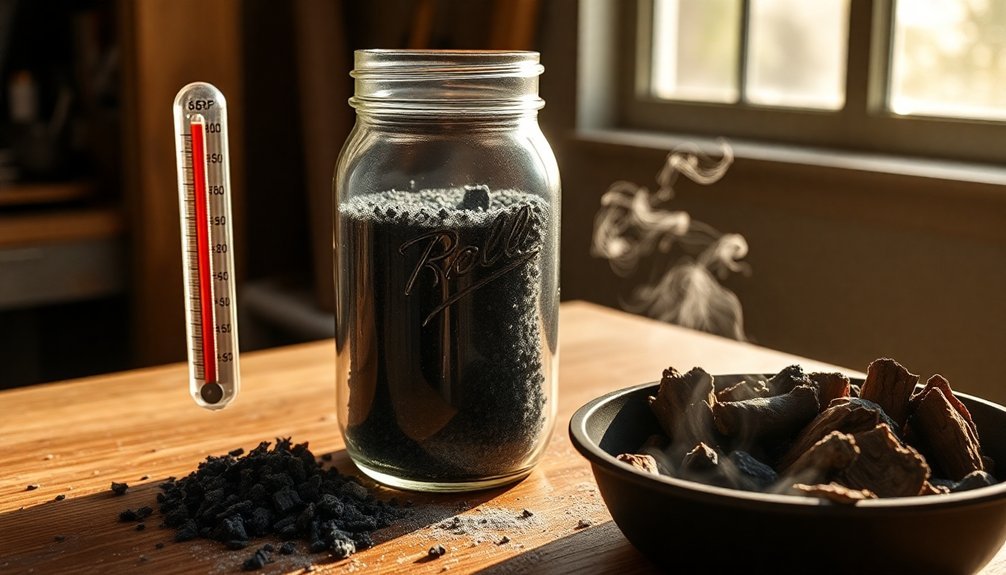To master temperature-safe food preservation with wood ash, you'll need to focus on three critical elements. First, store your preserved foods in a cool, dark location like a basement or cellar, maintaining temperatures below 5°C for high-risk items. Second, maintain precise ash layer thickness – use 1 to 1.5 inches of well-sifted wood ash around your foods, applying roughly 1.5 kg of ash per 1 kg of food. Third, adjust your preservation strategy with the seasons by increasing ash layers during warm months and using wooden boxes for insulation during cold periods. These fundamentals will set you up for deeper exploration into this time-tested preservation method.
Storage Environment Requirements

A proper storage environment is essential when using wood ash for food preservation. You'll need to select a cool, dark location like a basement or cellar that maintains consistent temperatures throughout the year. The area must be protected from direct sunlight and high temperatures, which can compromise both the food and the ash's effectiveness. Using hardwood ash specifically will provide the most reliable preservation results.
When setting up your storage space, verify it's well-protected from air and moisture intrusion, as these elements can lead to food spoilage. You'll want to keep your storage containers away from any combustible surfaces for safety.
The space should be organized to prevent cross-contamination between different food items, especially raw and cooked foods. You'll need to monitor the temperature regularly to maintain ideal conditions. Keep high-risk foods at 5°C or below, or above 60°C to avoid the dangerous temperature zone where bacteria thrive.
Don't place containers directly against walls or floors where temperature fluctuations might occur. Instead, use shelving that allows for proper air circulation. Remember to check your storage area periodically for any signs of moisture buildup or pest activity, as these can quickly compromise your preservation efforts.
Layer Ash Thickness Control
Building on proper storage conditions, controlling ash layer thickness stands at the heart of successful food preservation. You'll need to maintain a consistent 1 to 1.5-inch layer of sifted wood ash for best results, whether you're preserving cheese or tomatoes.
For cheese preservation, surround your hard cheese with 1 to 1.5 inches of finely sifted ash in a stoneware pot. Don't attempt this method with soft or medium cheeses, as their high moisture content won't respond well. Store the container in a cool cellar environment at 50°F for optimal preservation.
Remember that the ash will create a new rind, which you'll need to remove before consumption.
When preserving tomatoes, start with a 1.5-inch base layer of ash in your container. Place the tomatoes stem-side down and cover them with a thin ash layer. Continue this layering process until you've filled the container.
You'll want to use approximately 1.5 kg of ash per 1 kg of tomatoes for the lowest decay rate.
Before applying the ash, sift it multiple times to remove debris and sharp particles. This guarantees even distribution and better preservation results.
You can achieve higher preservation effectiveness by maintaining precise layer measurements and using properly sifted ash.
Seasonal Temperature Adjustments

Maintaining food preservation success throughout the year requires careful seasonal temperature adjustments to your wood ash storage methods.
During colder months, you'll find preservation easier as the natural temperatures align with ideal storage conditions of 15-25°C (59-77°F). However, you'll need to monitor your storage area to prevent extreme temperature drops that could affect food quality. Consider using wooden boxes or cardboard to provide additional insulation during these times.
When warmer seasons arrive, you'll need to take extra precautions. Consider increasing your ash layer thickness and relocating your storage to cooler locations like basements or underground spaces. If you're in a tropical climate, you might need to implement additional cooling measures to maintain proper preservation temperatures.
You should adjust your preservation techniques based on seasonal humidity changes too. In humid seasons, use well-sifted ash and guarantee proper ventilation without compromising the ash barrier.
Choose food varieties known for their long-keeping qualities during challenging seasons, and monitor your stored items more frequently during seasonal changes. Remember to check for signs of spoilage regularly, especially when temperatures fluctuate.
Frequently Asked Questions
Can Different Types of Hardwood Ash Be Mixed for Preservation?
You can safely mix different hardwood ashes for food preservation as long as they're from untreated sources like maple, oak, and hickory. Just guarantee they're well-sifted and completely cool before combining them.
How Do You Know When Preserved Food Has Gone Bad?
You'll know food has spoiled if you spot mold, discoloration, or sliminess. Watch for off-putting smells, unusual textures, and bulging containers. Don't consume anything that tastes sour or feels abnormally soft.
Is It Safe to Preserve Multiple Food Types in One Container?
You shouldn't mix different food types in one container. It's unsafe due to varying preservation needs and cross-contamination risks. Each food type requires specific storage conditions to maintain safety and quality.
Can Wood Ash Preservation Affect the Taste of Food Items?
Yes, wood ash preservation can affect your food's taste. You'll notice enhanced flavors in cheese, which becomes sharper like aged parmesan, and meat gains a pleasant hickory taste when you use hardwood ash.
Should Food Be Washed Before Preserving With Wood Ash?
While there's no strict requirement, you'll want to keep your food clean and dry before wood ash preservation. Don't wash it right before storing, as excess moisture can compromise the preservation process and effectiveness.
In Summary
You'll find wood ash preservation works reliably when you've mastered these three key elements. By maintaining proper storage conditions, controlling ash layer depth, and adjusting for seasonal changes, you're set for successful food preservation. Whether you're storing root vegetables or preserving meats, these temperature-safe techniques will help you keep your food fresh and protected throughout the year.





Leave a Reply